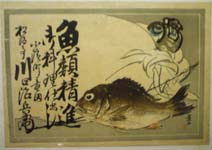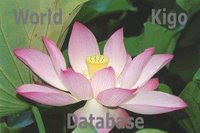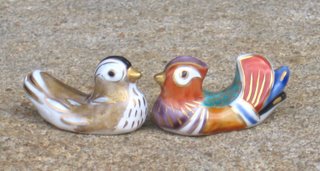:::::::::::::::::::::::::::::::::::::::::::::::::::::::::::::::::::::::::::::::::::::::::::::::::::::
Joge-e: Two-way pictures
上下絵 (じょうげえ jooge-e)

These are playful and funny images which were often created during the Meiji period.
Each viewing direction enables the viewer to see a different image.
:::::::::::::::::::::::::::::::::::::::::::::::::::::::::::::::::::::::::::::::::::::::::::::::::::::
quote
Joge-e, or “two-way pictures,” are a type of woodblock print that can be viewed either rightside-up or upside-down. Large numbers of these playful prints were produced for mass consumption in the 19th century, and they commonly featured bizarre faces of deities, monsters or historical figures (including some from China). Only a few examples of original joge-e survive today.
Here are a two with Daruma .
Created by Yoshitora, 1862.
Left column (top to bottom): 1. Tadafumi (Gedo, an evil person), 2. Hunter (Frog), 3. Small tengu (Big tengu), 4. Bad guy (Bad guy). Center: 5. Two-horned demon (One-horned demon), 6. Kasane, possessed female character in famous Kabuki play (Ugly man), 7. Daruma (Daruma). Right: 8. Foreigner (Ainu), 9. Nio guardian (A-un guardian).



.................................................
This print by Kuniyoshi (c. 1852) shows a Daruma and Tokusakari (a character from a famous Noh play). Viewed upside-down, the Daruma becomes a Gedo (an evil person) and Tokusakari becomes Ikyu (a character from the famous play “Sukeroku”).


Look at more HERE
© www.pinktentacle.com/
. Sukeroku 助六 - Hero of Edo .
Look at some Shadow Figures from the Edo Time
影絵
Kage-e (”shadow pictures”) — a popular form of Edo-period woodblock print — were appreciated by children and adults and commonly used as party gags. These pictures consist of two parts: a “shadow” image and a “real” image. The shadow image, which typically bears the shape of a common, easily identifiable object, is viewed first. The real image, viewed second, reveals the surprising true identity of the shadow.
© www.pinktentacle.com Kage-E
:::::::::::::::::::::::::::::::::::::::::::::::::::::::::::::::::::::::::::::::::::::::::::::::::::::
Nishiki Kage-E 錦影絵
Continuities and Discontinuities in the
Japanese "Motion-Pictures"
by Kato Hidetoshi
The prototype of Japanese native "motion-pictures" is Kage-e (shade pictures) or Te-Kage-e (hand-shade-pictures), originally a children's play. The play is very simple. It is the projection of the figures composed by hands and fingers to Shoji (paper sliding door) with candle-light. The fingers can compose, for instance the shape of the head of a fox, the shape of a man's face, and so forth. All you need is to extend your hands and fingers between candle-light and Shoji and move them, and the audience will enjoy the performance from the other side of Shoji.
It was an anonymous invention of Shoji and candle culture. Indeed, before the arrival of television and fluorescent light, Kage-e used to be one of the most popular winter entertainments among Japanese children.
 This art later became an adults' play, too. The oldest written record about Kage-e can be found in "Rakuyoshu", a collection of essays published in 1680, and according to this book, Kage-e could be an amateur theater. That is, a group of adults and children making up a play by hand-shades. The educators in the pre-industrial period used to stress the educational value of Kage-e very often. For example, a book titled The Book of Kage-e, published in the 18th century, says:
This art later became an adults' play, too. The oldest written record about Kage-e can be found in "Rakuyoshu", a collection of essays published in 1680, and according to this book, Kage-e could be an amateur theater. That is, a group of adults and children making up a play by hand-shades. The educators in the pre-industrial period used to stress the educational value of Kage-e very often. For example, a book titled The Book of Kage-e, published in the 18th century, says: "The most desirable way of raising very young children is to let them develop their own abilities, but because of their nature, they do not like complicated arts. Such arts are beyond their understanding and they cannot enjoy them. On the other hand, to give ordinary toys is also not ideal for children. Since toys are shaped in particular forms, they cannot absorb children's interests. They are bored by toys sooner or later. Kage-e meets with the psychology of children, because the shapes can be flexible. Kage-e is one of the most desirable educational means for young children".
It should be noted that the toys are defined as "shaped in particular forms". The essence of Kage-e is on the other extreme of something "shaped in particular forms". The basic characteristic of Kage-e is that it lacks "forms". Five fingers, sometimes with the aid of small items, such as chopsticks or matches, can produce various forms on Shoji. (In regard to the varieties of Kage-e, Katei Hyakka Jiten [Home Encyclopedia] of 1925 illustrates 31 basic forms.) A very minor move of finger can change the figure of a dog into the figure of a cow, and this sort of unexpected change is the joy of Kage-e. It is fundamentally different from such well defined games as a jig-saw-puzzle. It was an "informal" art of pre-industrial Japan.
The art of Kage-e has developed into a new stage by the invention of Nishiki-Kage-e. It was an optical projection of still pictures with the aid of candle-light to Shoji screen, and the invention is described as follows:
"The art of Nishiki-Kage-e was devised by a man named Toraku, who used to be a professional painter. By some chance he succeeded in projecting pictures painted on a small piece of glass enlarged by a lens of lookingglass. Thereafter, he painted picture stories on pieces of glass, and performed this art at vaudeville theaters (Yose), and as it became popular, he trained disciples in this new art."
In short, this was a kind of picture-slide projection using lenses. The lens itself might have been an import from the Netherlands, but the combination of glass-painting and Shoji screen was the original device by Toraku, and it should be emphasized that Toraku's invention was not only experimental, but also commercially successful as a vaudeville art. It was an established genre of popular culture in pre-industrial Japan.
As a matter of fact, the city people of the day seemed to be most interested in the projection, and many essay journalists of late 18th century referred to this invention. Since the audience reaction was very active, the performers, i.e., Toraku and his disciples, were encouraged to refine the art. The painting became fullrange color, and the performance came to be accompanied by music. The stories were taken mostly from Kabuki script. Indeed, a conservative critic was somewhat disgusted by the "color and music" and wrote that "the essence of Kage-e is in a quiet, small group setting, not in noisy vaudeville theaters." And such remarks remind us of classicist response to Cinemascope which insists that the best of movie is in standard size screen with monochrome effect.
The development of Nishiki-Kage-e (which later was called Utsushi-e), however, continued all through the first half of the 19th century, and as a result, Japanese Kage-e artists finally succeeded in making "motion-pictures" with multi-screen technique, and this evolution of pictorial projection was most impressive.
The inventor of the "motion-pictures" is unknown. But a man by the name of Bunraku Tamagawa who lived in the suburb of Tokyo in early 19th century was a well-known performer of the multi-screen, and his projectors and slides (glass-paintings) art still being kept in good condition.
Read it all HERE
© kato database
.......................................................................

Daruma Story for a Spooky Night ..... だるま夜話 Daruma Yobanashi
(utsushi-e 写し絵, kage-e 影絵人形劇)
:::::::::::::::::::::::::::::::::::::::::::::::::::::::::::::::::::::::::::::::::::::::::::::::::::::
This is a thin towel (tenugui) which shows different images when folded

© misdirection.oops.jp
:::::::::::::::::::::::::::::::::::::::::::::::::::::::::::::::::::::::::::::::::::::::::::::::::::
Trick Pictures of the Edo Time
Edo Kakakuri Zuan 江戸からくり図案


B-03:寄せ絵「ふんだんだるまづ画」
松葉桜関斎(1847~1852)だるまのおもちゃを寄せ集めた顔。
Matsuba
The face is made from Daruma toys.

B-06:一筆描「一筆達磨」
喜多川歌麿(1800~1818)法衣が一筆描。
Kitagawa Utamaro
The robe of Daruma is painted with one stroke.
Look at the details HERE
© www2s.biglobe.ne.jp

Design with WA
Design with Folk Art
Design with Folk Toys
Including Daruma san
Design with FOOD
DARUMA

Design with Buddha Statues
CLICK HERE for more
... Design Index ...
Take your time exploring this Digital Design Net !!
:::::::::::::::::::::::::::::::::::::::::::::::::::::::::::::::::::::::::::::::::::::::::::::::::::
Edo Patterns, share 洒落
Kamawanu, Kikugoro goshi and other puns
Picture Puzzles, Rebus Pictuers hanji-e 江戸の判じ絵
Daruma Story for a Spooky Night .....
だるま夜話 Daruma Yobanashi
Tatebanko Diorama Toys / 立版古(たてばんこ)
. Karakuri ningyoo からくり人形 mechanical dolls .
. gangu eshi, e-shi 玩具絵師 painter of toys .
and legends about toys
:::::::::::::::::::::::::::::::::::::::::::::::::::::::::::::::::::::::::::::::::::::::::::::::::::::::::::::::::::::::::::
[ . BACK to DARUMA MUSEUM TOP . ]
[ . BACK to WORLDKIGO . TOP . ]
:::::::::::::::::::::::::::::::::::::::::::::::::::::::::::::::::::::::::::::::::::::::::::::::::::::::::::::::::::::::::::

















































